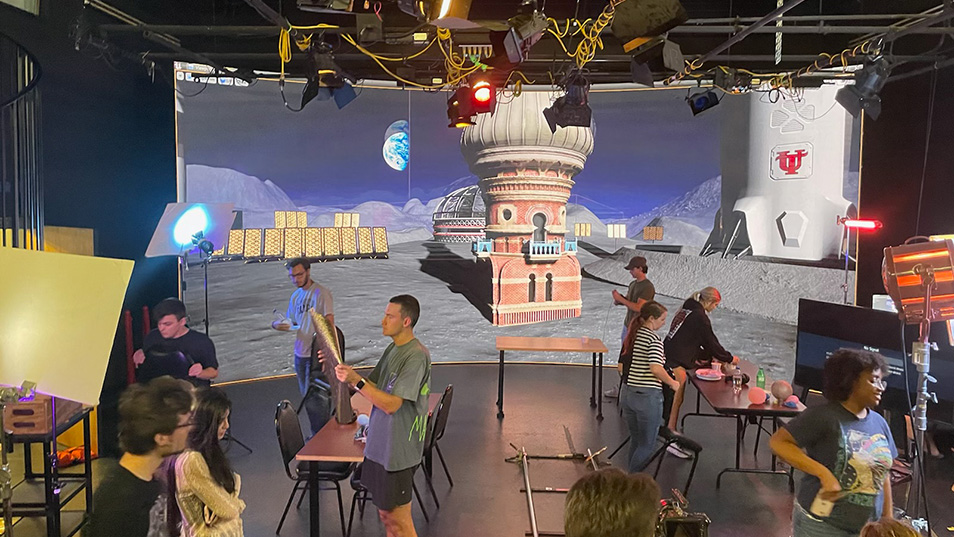Published: March 21, 2017
UT Announces New Academic Building for Graduate and Health Studies
To support academic needs in its expanding health sciences and graduate programs, The University of Tampa has announced it will build a new, six-story academic building in the heart of campus.
The nursing program, recently named Florida’s best, will be housed in the new building, as well as the program in physician assistant studies under development, UT’s Office of Graduate Studies, classrooms, health sciences labs, study spaces and faculty offices.
The Graduate and Health Studies Building will be constructed on what is currently the intramural field in the center of UT’s campus, just east of Pepin Stadium. The building will blend with the architecture of UT’s campus, with red brick, precast concrete, metal and glass. It will offer panoramic views of campus and downtown Tampa, and will include typical Florida landscaping.
At 90,000 square feet, the building will be UT’s largest academic building.
“With this facility we hope to strengthen UT’s health sciences programs with state-of-the-art spaces, including simulation labs, a digital anatomy lab and all the latest health technology and equipment,” UT President Ron Vaughn said. “Plus, this building will enhance our graduate programs.”
The building will also have a state-of-the-art audiovisual system, the same as used in health care facilities, that is designed to capture clinical and learning events for future review and assessment by students from anywhere. This will help to facilitate a unique connectivity to other health care facilities, enhancing the student clinical experience.
The building is expected to be completed in Fall 2018.
Construction of future academic buildings on campus will focus on sciences and the arts. A second phase of the Graduate and Health Studies Building, which includes a twin, 90,000-square-foot adjoining academic building, will also be built in the future, but the timetable has not yet been set. This building will be UT’s Technology Building, housing the many academic programs related to technology and much of UT’s administrative technology support systems. The two buildings are planned to be joined by a three-story sky bridge to allow for additional functional space with superb campus views amidst the pedestrian corridor between the two buildings.
While it will be the biggest, the Graduate and Health Studies Building follows a number of new or completely renovated spaces built on campus since 2000 that function for primarily academic purposes. It follows the Sykes College of Business (2000), Marine Science Field Station (2002), R.K. Bailey Art Studios (2003), Edison Building (2003), Ferman Music Center (2005), Falk Theatre (2005), Scarfone/Hartley Gallery (2007), Cass Science and Communication Building (2008), Science Annex (2010), Sykes Chapel and Center for Faith and Values (2010), Nursing Skills Lab (2011), MacKechnie Academic Building (2011), Health Sciences and Human Performance Building (2012), Schoomaker ROTC and Athletics Building (2013), North Walker Hall (2013), East Walker Hall (2013), West Walker Hall (2014), Daly Innovation and Collaboration Building (2015), and Kennedy/Boulevard Academic Building (2016).
Construction of the Graduate and Health Studies Building will be paid for through a combination of individual gifts and University funds. An official name of the new facility will be announced at a later date.
In alignment with UT’s commitment to create a responsible, efficient, healthy and sustainable campus, the building was designed to be a candidate for Leadership in Energy and Environmental Design (LEED) certification by the U.S. Green Building Council.
The team of Beck Architecture and KWJ Architects designed the building, which will be constructed by Beck.
Floor-by-Floor Details
FIRST FLOOR — General classroom space along with student gathering areas and study spaces. “Smart” classrooms will incorporate tiered seating.
SECOND AND THIRD FLOORS — 30,000 square feet designed for UT’s program in physician assistant studies under development. This facility includes a clinical skills lab, patient simulation labs, assessment rooms, digital anatomy lab, classrooms, study spaces, offices, a conference room and a unique moulage room, which is a specialized room for applying mock injuries for student training.
FOURTH AND FIFTH FLOORS — Dedicated home of UT’s nursing program. This 30,000 square feet of nursing space includes a reception area, a large patient care center, ICU simulation rooms, health assessment clinical spaces, a student lounge and study spaces, faculty and staff offices, a large conference room and classrooms. “It will be a top-notch facility for our top-notch program,” said Vaughn.
SIXTH FLOOR — The sixth floor will include a reception area, a student study area, a conference room, classrooms, approximately 25 faculty and staff offices and other workspaces to provide support to UT’s Office of Graduate Studies. Additionally, until a new science building is built, this floor will temporarily house two physics labs, a physics classroom and a physics research lab.



